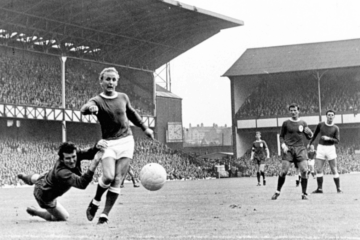by Tony Onslow / Jamie Yates
[The original article was by Tony Onslow of EFCHS, now updated here, expanded and re-edited by Jamie Yates. Jamie has also added the entire section at the end, under ‘Further Research by Society member etc.]
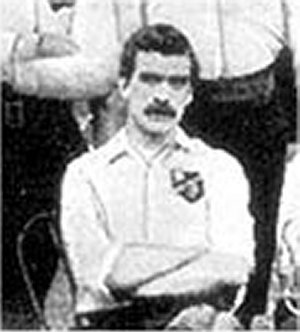
No other player forged a tighter bond with the early development of Everton Football Club than ‘good old’ Mike Higgins who can surely lay claim to the title of ‘Original True Blue’. He can be found representing Everton at Stanley Park shortly after his 18th birthday in October 1880, scoring goals during the club’s one-year tenure at Priory Road and taking part in the first match at Everton’s new ground, Anfield, in September 1884. He stands out in early Everton team photographs, strikingly dashing and distinctive with his shock of curly, jet-black hair, brooding eyebrows and moustache.
Higgins was by far the longest serving member of the playing staff, when Everton became founder members of the Football League. Running out at Aston Villa in September 1888, he was the only remaining player from the friendly kickabouts of Stanley Park who made it all the way to the heady heights of competing in the first season of organised league football in England. He was still only 26 years of age, but this would turn out to be his final appearance in an Everton first team jersey. Still, what a journey he had completed.
Mike Higgins’ Dublin-born father, Michael Higgins, a painter, and Carlisle-born mother Eleanor Musgrove Barnes, a dressmaker, were married in Liverpool in the summer of 1857, but were living at Great Yarmouth when their first child Patrick Thomas (known as Thomas) was born in 1859. They had relocated back to Liverpool and were living at 6, Upper Essex Street when their second son, Michael, was born on 30 June 1862. He was christened Michael Higgins at the church of St John the Baptist in Toxteth on 20 September 1862, although later documents record his full name as William Michael, and he would grow up to be known to most as Mike. The 1871 census found the Higgins family living at 34 Collins Street, Toxteth, but by 1881 they had moved north, across Liverpool and were residing at 58 Berry Street in Bootle. Young Mike Higgins was working in the upholstery trade when he was first reported to be playing football for Everton in the summer of 1880.
Higgins played for Everton’s second XI before gradually establishing himself in the first team, initially as a left-sided forward. He was selected for the Liverpool & District XI, against their counterparts from Walsall, in a game that was organised as an opening fixture at the new enclosure at Priory Road. Higgins was part of the Everton team that first lifted the Liverpool Senior Cup in 1884, with a win over Earlestown, and was in the side that won it again in 1886, beating Bootle. He took part in the first game at Anfield, against Earlestown, and played on as its capacity gradually increased to around 20,000. Even as the influx of crack Scottish players into the Everton squad took hold, Higgins was still able to command his place in the first eleven.
According to early Everton historian Thomas Keates, owing to a badly broken leg, club secretary Frank Brettle was unable to carry out his duties in full during the 1885/86 season and the role was handed to a man named Thomas Higgins. It is impossible to prove with any certainty whether this individual was Mike Higgins’ older brother, although Thomas was employed as a clerk or bookkeeper for a shipping company throughout this period, so would appear to have been well cut out for the administrative duties involved as the Everton team, inspired by new club captain George Dobson and star forward George Farmer, began to make real progress. The following passage is taken from Thomas Keates’ golden jubilee publication ‘History of the Everton Football Club 1878/9-1928/9:
‘Owing to Mr. Brettle’s disablement, Mr. Thos. Higgins undertook to act as secretary, with Mr. Brettle as his assistant, for 1885-6. The season was a very successful one, the attendances and the takings at the gates continually increasing. The demands of Mr. Higgins’ commercial occupation, however, compelled his retirement from the secretaryship at the end of the season.’
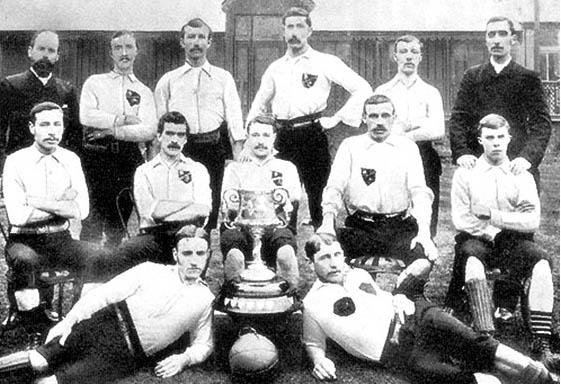
One of the original footballing utility men and a real team player, Higgins had begun his Everton career playing amongst the forwards but later moved to half back, a position in which he took part in all the four F.A. Cup games that were required to eliminate Bolton Wanderers from the contest in October and November of 1887. Everton were famously banished from the competition and suspended from playing until 5 January 1888 after finally knocking Bolton out on the grounds of having selected no fewer than seven illegitimate players to face Bolton. This notwithstanding the fact that by the time the F.A. ruling was handed out Everton had themselves been beaten 6-0 in the following round by the mighty Preston North End team. At a subsequent Everton committee meeting held on 20 December 1887, club secretary Alex Nisbet reported Mike Higgins and teammate William Briscoe for ‘playing football during the term of the suspension’. With Everton considering appealing the general ban it appears that no further action was taken against either Higgins or Briscoe.
Better news was to follow in the new year as Mike Higgins became the first Everton player to officially be granted a benefit match, played at Anfield on Saturday, 26 May 1888. The opposition was provided by a team selected by Major William Sudall of Preston North End, which consisted mainly of Burnley players who had been imported from Scotland. Mike Higgins was one of seven Everton players in a home side that included players from both Bootle and Stanley. Around 10,000 people saw the home XI win the game 2-0 with a brace from Robert Jamieson (not to be confused with defender Jimmy Jamieson), the Bootle striker, who, like Mike Higgins, would later make a sole Football League appearance in Everton colours. Later that evening a banquet was held at the Sandon Hotel and Mike Higgins was guest of honour.

The amount of money taken at the gate was reported to be £90, and this clearly astounded reporters from the national press who had attended the game. The following article appeared in the Athletic News of 29 May 1888 under the title ‘Who would not be an Evertonian?’:
‘Who would not indeed, after the magnificent recognition the service of Mike Higgins to the Everton club received at the Anfield enclosure on Saturday. Mr Higgins has been associated with the fortunes of the club through all its phases of title until it has risen to rank among the leading organisations of the country and is the last playing member of the old team. Gentlemanly, unassuming and esteemed by all. Of this, the 10,000 present bear irrefutable testimony, and it truly will be questioned whether any other football player has had such an overwhelming testimony of his service.’
Everton Football Club had Mike Higgins’ registration firmly in place when they began playing in the Football League but called upon his services only once. On 22 September 1888 he was selected to appear in the half-back line one final time for the game against Aston Villa at Perry Barr, a match which Everton lost 2-1. Higgins was then placed in the reserve pool of players and was not retained at the end of the season. His footballing days, however, were not yet over.
Higgins, along with several other former Everton players, formed an amateur side which they christened Everton Athletic. Their first fixture, against Lancashire Nomads, was played at Anfield before they managed to secure their own pitch a mile or so down Belmont Road at Strawberry Pleasure Gardens. This enclosed location, off West Derby Road where it meets Boundary Lane, contained a tavern, tea rooms which were also used for dancing and an area for outdoor recreation. The club acquired a list of fixtures that began with a visit from Blackburn & District. The new venture caught the eye of the editor of the ‘Cricket and Football Field’ and the journalist whom he sent to Liverpool, presented him with this account of what he found.
‘The prospect of gazing at a football match in a deluge without shelter hardly, was anything but inviting. But I braved the elements and made a move in the direction of the so-called Strawberry Gardens. The entrance to the ‘Gardens’ is obtained from West Derby Road through a gut that cannot be termed a road or street. This admits you to a large expanse of wasteland which, with the rain, was in the most deplorable condition, small lakes of accumulated rainwater lying in wait to entrap any incautious stranger whose thoughts should be to occupy his mind as to obscure the vision.
“Abandon hope all you who enter here” would have not been an ill-fitting title on Saturday had it been placed at the entrance of the inhospitable region. However, I carefully piloted myself towards a door around which a small knot of sons of toil were gathered, seriously engaged discussing the merits and demerits of the Everton team and prognosticating another win for them over Notts County. Having planked down my humble 3 pennies and entered the enclosure, I was extremely surprised to find myself in a smart little ground looking spick and span with new palings, partitions and goal posts. In width it had an appearance of being short of the regulation distance. I may have been deceived, still it looked like it, but this was remarked upon by several of the spectators, whom by the way numbered around 500.
A man was busily engaged sprinkling sawdust on the turf in places where it was most damp and they were more numerous than otherwise. May I add that the arena is not what may be called level as a bowling green, but apart from the deep hollow near the top goal, it was fairly level. To sum up, it is a very cosy enclosure, somewhat cramped, but well sheltered from the biting wind.’
(The Cricket and Football Field, 26 October 1889)
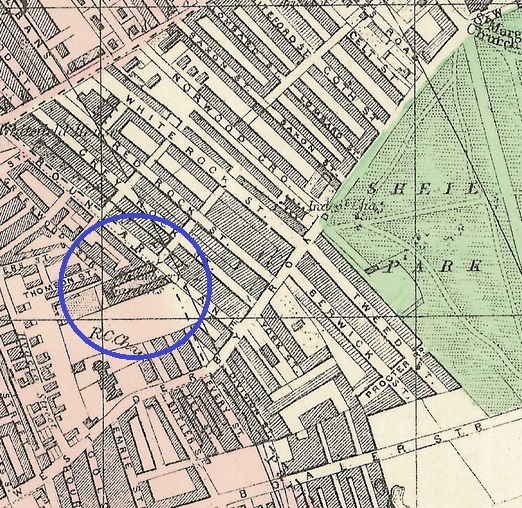
(from 1890 Ordinance Survey map)
Everton Athletic got the new campaign off to a good start by beating their visitors 5-2. Fixtures with Leek and Rotherham then followed before an alarming article appeared in the sporting press:
‘Many of our readers will hear with regret that Mike Higgins (Good Old Mike) the old Evertonian, is lying seriously ill at his residence in Liverpool. All who know the veteran will wish him a speedy recovery.’
(The Cricket and Football Field, 11 November 1889)
This information was followed up by the Liverpool Echo who reported.
‘We hear that Mike Higgins died yesterday from internal inflammation.’
These articles would have come as an almighty shock to the former Everton player because he was in good health and living at his home in Bootle. He played out the whole campaign with his new club who, the next season, were joined occasionally by another former Everton player, George Farmer who lived a short walk from the Strawberry Gardens and played bowls there. Nevertheless, it soon became clear that the Liverpool public were not prepared to pay money to watch the standard of football played by Everton Athletic and they disbanded without completing their list of fixtures.
The 1901 census found Mike Higgins, unmarried, and living with his mother at 44 Back Lane within the parish boundaries of St Mary the Virgin church at Great Crosby. On 15 March 1906, William Michael Higgins married Stratford, Essex-born Louisa Perry at the church of St Paul in Barrow-in-Furness. They both listed their address as being 60 Kendal Street. By the time of 1911 census, the couple were living at 15 Park Terrace, Heathwaite in Windermere where the head of the household continued to work as an upholsterer. Mike’s mother, by now 83-year-old Eleanor Higgins, a widow since the death of Mike’s father Michael in 1888, still lived with them.
……………………………………………………..
Further research by Society member Jamie Yates has revealed what became of Mike Higgins, the ‘Original True Blue’.
The Football Echo letters pages in Liverpool during the summer of 1928, as newly crowned Football League champions Everton Football Club prepared to celebrate the Golden Jubilee of the club’s formation, were awash with exchanges about ‘the old timers’, the early days of football on Stanley Park, Everton at Anfield and so forth. Supporters from those formative years were clearly by now ‘of a certain age’ and harking back to younger days, sharing memories of walking with their Everton heroes from their Sandon Hotel club house to Anfield on a matchday, specific games and notable characters.
Popular sportswriter Ernest ‘Bee’ Edwards’ column ‘Bee’s Notes On Sport’ of 28 August 1928 contained the following, which appears to have sparked this outpouring of Evertonian nostalgia:
‘I saw some time ago (says Mike Higgins) the Everton F.C. was having their “jubilee,” and I wondered how many of the “old original” members of the Everton United Church Club and the St. Domingo F.C. could be traced. The members who me and formed the Everton Club (they were mostly players), and played in Stanley Park, and afterwards at Priory-road. I won’t weary you with the perpetual picnic we used to have each weekend, and the feeds after the match, “hot-pot” at Clark’s, Village Street (Everton-village). Please excuse me writing to you, but am pleased to read any remarks about past or present players of either Everton or Liverpool (the old original E.F.C.), and if you should use any of this in your notes, please leave my address out at present.’
A few of the responses to Mike’s plea for supporters and old club members to come forward with their memories follow below:
THE OLD FOLKS AT HOME
“I was surprised to read in your notes a letter from our old half-back Mike Higgins,” says Mr. W. Eyton. “I think that a photograph of the old team was taken by a photographer at the bottom of Spellow-lane, 1882-1883, and in the right-hand side poor broken-backed Jimmie Higgins; also in the centre, half-back, curly-headed Mike Higgins. His curls were the admiration of the team. There is a second photograph by Hinchcliffe, Scotland-road, which can be seen at Mr. Martin’s, hairdresser, Blessington-road, Anfield; Mike in his county cap, black velvet and silver tassel. I should like you to know Mike, and he would be able to tell you many stories of the formation of the Everton Football Club; also of the enjoyable evenings spent after the matches at the expense of the team. He would also tell you about teaching the late Edwin Berry how to play half-back; also Teddy Corey and his funny jokes, and the trouble with the Parks Committee; also the kindness of the late John Houlding (King John of Everton), who fought for the boys of Everton to keep the ground in Stanley Park in 1884-1885.”

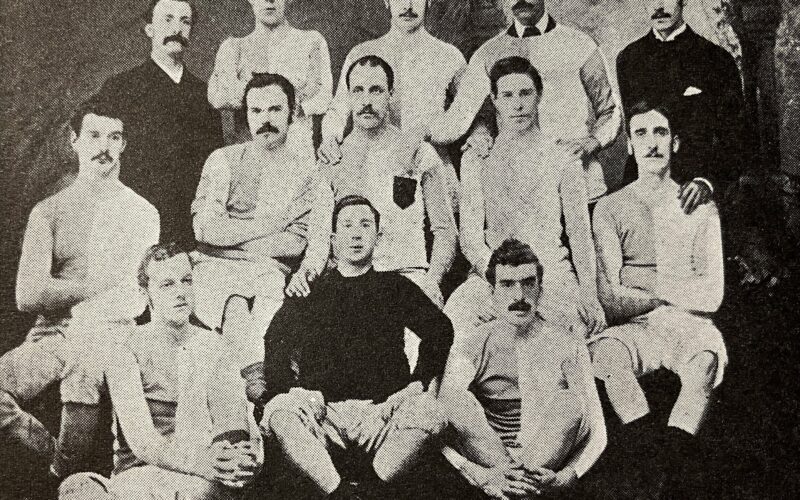
Mr. Harry Williams writes:
‘I had an enlargement of the photograph made, which the Everton directors have kindly accepted as a jubilee gift. I knew Mike Higgins intimately. He was the most versatile player, and one of the best. I should like to be remembered to him. He mentions ‘Clark’s,’ in Village Street, the first headquarters of the club. Young Clark was secretary, and the hotel, Queen’s Head, I think, was kept by his father. The house has long since ceased to operate as a pub. There used to be weekly wrestling bouts held in a building at the rear.’
(31 August 1928)
THE OLD SCHOOL
Mr. Thomas P. Bethell writes:
I note the remarks by Mike Higgins respecting Everton United Church Club and St. Domino F.C. As one of the members of the then E.U.C.C., also of the F.C. section, I am glad to find Mike sticking up for the part we played in the original club, and the fusion that formed the Everton Club. I had a wordy tussle on this subject a few years ago regarding the transition of title that gave the Everton Club its name. will you kindly convey my greetings to Mike Higgins, for which I enclose a stamped envelope.’
(5 September 1928)
‘Mr. Dick Banks, of Allerton, writes:
In your notes I saw the address of Mike Higgins was wanted, so here goes. It is now some twenty-three years since I played for my county, and Mike was my guide, philosopher, and friend in such matters. He was than an upholsterer in Ambleside, and always took a keen interest in matters regarding football. In 1907 we two coached a team of youngsters which won the Westmorland Junior Shield, so you will see that he was, and is still, very much alive. He afterwards set up for himself as an upholsterer, and is now resident in Windermere, as far as I know, and a very useful citizen. I came across him about twelve months ago, when he handed me his business card, which I am sorry to say I have mislaid, or would have enclosed it. If you write to Mike Higgins, upholsterer, Windermere, I think you will find him, as he is well-known up there.’
(21 September 1928)
After the conclusion of his playing career, Mike, his wife Louisa and mother Eleanor had indeed settled in the Lake District. There Mike continued to make a living as an upholsterer, while keeping a hand in from a football perspective coaching boys who played for the Westmoreland County team. At some point, however the family relocated again, to Bury, Greater Manchester, presumably with Mike seeking improved employment opportunities. Back in Bootle, Mike’s brother Thomas sadly passed away aged just 36 in the winter of 1895, leaving behind his wife, Wolverhampton-born Lucy and four children under the age of six. Lucy never remarried and raised her four children, three daughters and a son, while rising to the position of forewoman-tailoress at Lewis’s, the well-known department store on Ranelagh Street in Liverpool.

Early in 1920 Eleanor Higgins passed away in Bury at the ripe old age of ninety-one. She was laid to rest on 23 January 1920 at Bury Cemetery, which backs on to Gigg Lane, site of the home ground of Bury Football Club since 1885. Mike Higgins played and scored for Everton against Bury at Anfield, though Everton’s first team don’t appear to have made the journey to the Gigg Lane ground until they travelled for a friendly at the end of March 1894, returning thereafter in January 1896 for a league fixture, during Bury’s first season as a First Division football club.
The 1921 census details Mike and Louisa Higgins living at 28 Woodfields Terrace in Bury, the address where they would see out their days. Mike’s age was recorded as 55 years, 11 months, when in fact he would have turned 59 in June of 1921. He was still at the very least seeking work as an upholsterer and an employer is listed, one A. Axford of Bolton, but below this is appended the term ‘out of work.’ This document confirms once and for all that the couple, who were of course into their thirties at time of marriage, had never had children. Louisa Higgins died, aged 68, in November of 1933 and was buried that month with her mother-in-law, Eleanor, at Bury Cemetery.
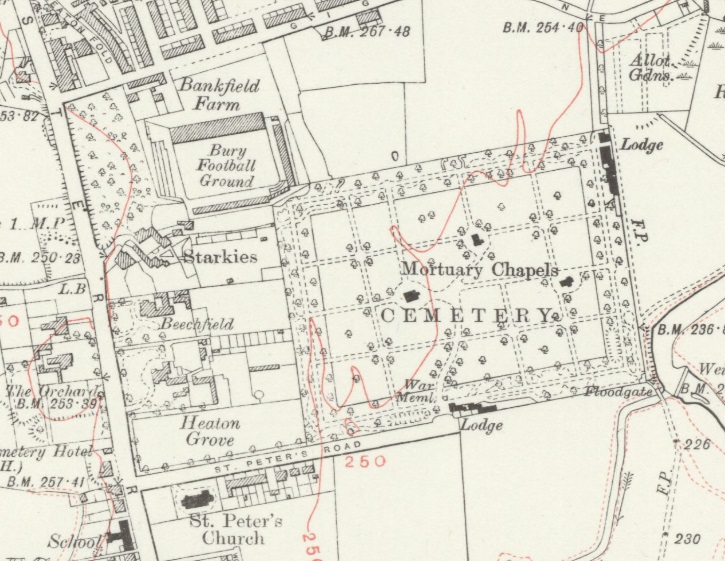
The great early Evertonian Mike Higgins passed away, aged 72, on 20 January 1935 at Fairfield General Hospital, formerly Bury Union Workhouse, from cardiac failure and having suffered from cancer of the tongue. Despite having lived the last year or so of his life alone after the death of Louisa, he died in the presence of his niece, Elsie Musgrave Higgins, who had travelled from her home at 311 Longmoor Lane, Fazakerley in Liverpool to be with him at the very end.
Mike was interred at Bury Cemetery, with Louisa and Eleanor, on Wednesday, 23 January 1935, 15 years to the day since his mother was laid to rest. Three days later Everton travelled to Roker Park to face the mighty Sunderland side of Raich Carter for an F.A. Cup fourth round tie. The match ended in a 1-1 draw, Jimmy Cunliffe scoring a late equaliser for the Toffeemen to force a replay at Goodison Park. This match was scheduled to place a week after Mike Higgins’ funeral and would go down in Evertonian and F.A. Cup folklore.
On the cold, wet evening of Wednesday, 30 January 1935, 59,213 supporters of two of English football’s all-time great clubs packed the Goodison stands to roar their teams on. Everton raced into a two-goal lead thanks to a Cunliffe double., but Sunderland pulled a goal back before half-time. Alex Stevenson extended the Blues’ lead early in the second half, before two late goals for the Mackems tied the score again at 3-3, forcing extra-time. Cunliffe completed his hat-trick two minutes into the additional period, but Sunderland hit back to make it 4-4. With Goodison Park fit to burst amid the din and fervour, England winger Albert Geldard’s two goals in the second half of extra-time made the final score 6-4 to Everton. Ten goals – not one of them scored by Everton skipper William Ralph Dean, mind you – and a match which was talked about for years as the greatest F.A. Cup tie ever played (there is a brilliant write-up on the match in Ken Rogers’ seminal Evertonian publication ‘Goodison Glory’).
There must have been a good number of older spectators in attendance that night who would have recalled the name Mike Higgins from their youth with a wistful gaze and a swell of joy in their hearts, the like of which only football adulation can muster.
It is safe to say that ‘good old’ Mike Higgins would have loved every minute of it.



